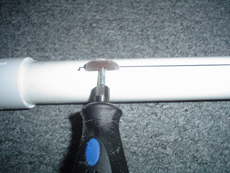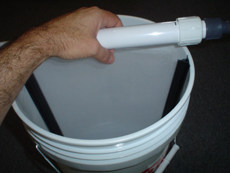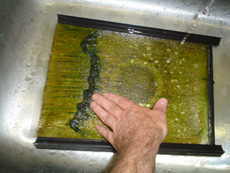How to Build an algae filter by Santimonica
An algae filter is the only filter that can bring tank's Nitrate and Phospate level down to zero. In this page, we will discuss how to build an algae filter step by step.
Please read here for the detail description of an algae filterFirst, get your screen. Any stiff material that has holes in it, like knitting backing, plastic canvas, rug canvas, gutter guard, or tank-divider will do. Try going to hardware stores, craft stores, garden stores, sewing stores, or just get one of these online (in order of preference):
Rug Canvas at herrschners.com Tank Divider at aquaticeco.comDon't use window screen though. The main problem with this kind of "soft" screen will be getting it to hold its shape; it will bend and fold too much. Stiff screen is easier to make stay put, and easier to clean.
If you have a nano with a filter hatch on top of the hood, then it's super easy: Just cut a piece of screen to replace the sponge filter, and put it where the sponge filter went. Leave the hatch open, an set a strong light on it, facing down directly on the screen. This is a good bulb to get; it will be bright enough to power the screen, and to light up your nano too:
Compact Fluorescent Flood - 5100K Natural DaylightIf your nano does not have a filter hatch on top of the hood, or if you have a regular tank, then here are the larger versions:



The first and main thing to consider is the flow to the screen. You need about 35 gph (gallons per hour) for every inch of width of the screen. Thus, a 2" wide screen would need 70 gph, and so on. Here is a chart:
| Screen Width | Gallons Per Hour (GPH) |
| 1" | 35 |
| 2" | 70 |
| 3" | 105 |
| 4" | 140 |
| 5" | 175 |
| 6" | 210 |
| 7" | 245 |
| 8" | 280 |
| 9" | 315 |
| 10" | 350 |
| 11" | 385 |
| 12" | 420 |
| 13" | 455 |
| 14" | 490 |
| 15" | 525 |
| 16" | 560 |
| 17" | 595 |
| 18" | 630 |
| 19" | 665 |
| 20" | 700 |
Note that it does not matter how tall your screen is, just how wide it is. Let's start with an overflow feed: In this case the amount of flow is pre-determined by how much is overflowing; the maximum flow you'll get to the screen will be what's going through your overflow now. This is easy to figure out by counting how many seconds it takes your overflow to fill a one-gallon jug:
60 seconds = 60 gph
30 seconds = 120 gph
15 seconds = 240 gph
10 seconds = 360 gph
8 seconds = 450 gph
5 seconds = 720 gph
Take this gph number that you end up with, and divide by 35, to get the number of inches wide the screen should be. For example, if your overflow was 240 gph, then divide this by 35 to get 6.8 (or just say 7) inches. So your screen should be 7 inches wide. How tall should it be? As tall as can fit into the area you have, and, as tall as your light bulbs will cover. But how tall it is not as important as how wide it is.
Pump feeds: Since with a pump you have control over the flow, start with the size screen you can fit into your space. If the screen will go into your sump, then measure how wide that screen will be. If the screen will go into a bucket, then measure how wide that screen will be. Take the width you get, and multiply by 35 to get the gph you need. For example if you can fit a 10 inch wide screen into your sump or bucket, then multiply 10 by 35 to get 350 gph. Thus your pumps needs to deliver 350 gph to the screen.
You can construct your setup using any method you like. The only difficult part is the "waterfall pipe", which must have a slot cut lengthwise into it where the screen goes into it. Don't cut the slot too wide; just start with 1/8", and you can increase it later if you need to, based on the flow you get. I used a Dremel moto-tool with a "cut off wheel":

Now install the pipe onto the screen/bucket by tilting the pipe and starting at one side, then lowering the pipe over the rest. You may have to wiggle the screen in some places to get it to fit in:

Lighting: This is the most important aspect of the whole thing. You must, must, have strong lighting. I'll list again the bulb I listed above:
Compact Fluorescent Flood - 5100K Natural Daylight... This the minimum you should have on BOTH sides of your screen. You can get even higher power CFL bulbs, or use multiple bulbs per side, for screens larger than 12 X 12 inches, or for tanks with higher waste loads. The higher the power of the lighting on the screen, the more nitrate and phosphate will be pulled out of the tank, and faster too.
Operation:
Regardless of which version you build, the startup process is the same. First, clean the screen with running tap water (no soap) while scrubbing it with something abrasive. Then dry it off and sand it with sandpaper on both sides. Then get some algae (any type) from your system and rub it HARD into the screen on both sides, as deep and as hard as you can. Then run tap water over the screen to remove the loose algae pieces; you won't see the spores that stick... they are too small, but they are there. Don't forget this algae rubbing part... it will speed up the start of your screen by a few days. Install the screen and turn on the water.
You can leave the light on for 24 hours for the first week if you want to speed up the process; otherwise just put it on a timer for 18 hours ON, and 6 hours OFF. You will see absolutely nothing grow for the first two days. On day 3 you'll start seeing some growth, and by day 5 most of the screen should have a light brown coating. If this level of growth does not happen on your screen, your lighting is probably not strong enough, or it's not close enough to the screen. Increase the bulb power, or move it closer.
When the screen looks something like this

...then you want to give it it's first cleaning, on ONE SIDE only. Take the screen to the sink, run tap water on it, and just push the algae off with your fingers (not fingernails):

Wait a week, and clean the other side, gently. Wait another week and clean the first side again, etc. After a while you'll have to press harder to get the tougher algae off, and after a few months you'll probably need to scrape it with something, and it may eventually get so strong that you'll need a razor blade to scrape it off. But for now, be gentle; you always want some algae to remain on the screen when you are done. NEVER clean it off completely.
Don't forget to test your Nitrate and Phosphate before you start your filter, and each day after. I use Salifert:
Salifert Test Kits Please click here to discus the Algae Filter





